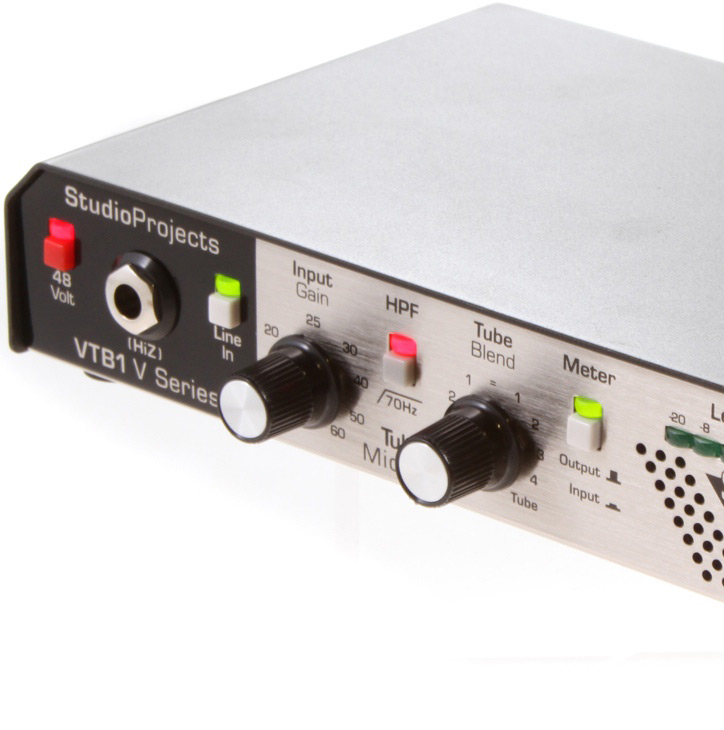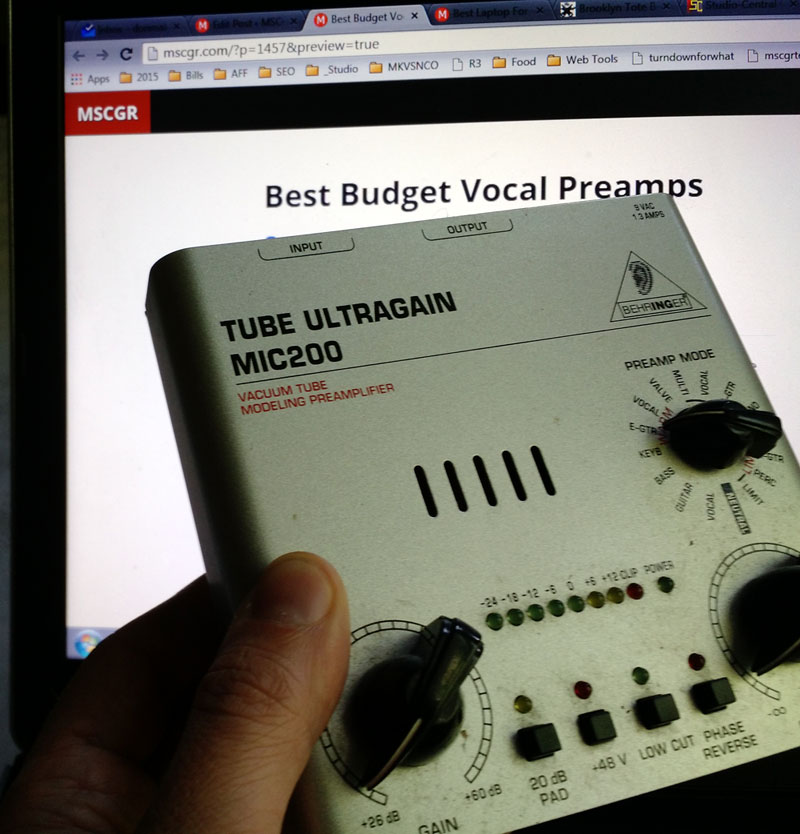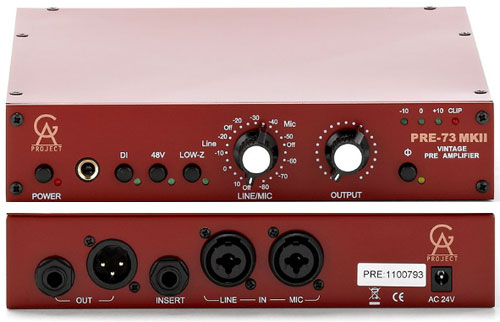
Studio Projects VTB1
Microphone Preamp
Buy from Amazon $179.99We receive a small kickback from our partners when you click through and purchase the great gear we recommend. Details
Best Budget Microphone Preamps
Studio Projects VTB1
- Don Makoviney
- Last Updated: April 5, 2016
The Studio Projects VTB1 is one of those pieces of music gear that gives you excellent sound, reliability and flexibility at a very reasonable price. It is flexible because you get solid state and tube circuitry in one preamp. With over a decade of user reviews and resounding acclaim from audio experts, it has a solid reputation as the best budget microphone preamp. The Studio Projects VTB1 is the best budget microphone preamp for most people.
This guide, and our picks, are for those of you who already have the run-of-the-mill preamps and want to go a step further.
Naturally there is no universal “best” preamp, as it often depends on a number of factors. These include the type of music you are making, the unique features of the vocalist, and what you are trying to accomplish with your sound.
Could I just use the preamps that are already on my audio interface?
Yes. You totally can. For instance, Focusrite has some really great preamps on their Scarlett line of digital audio interfaces. However, as your home recording skills grow, you will want more flexibility to shape the sound going into your DAW.
One user said it best in a studio forum:
You can get away with a track or two on a bad [preamp], but the effect really starts to get obvious with multiple tracks on bad [preamps]. What you’ll see is lack of clarity, loss of focus…kind of a smeared, blurry quality to the overall mix. [Preamps can be compared] to microscopes…the better the microscope, the more fully it will capture the image you’re looking at. Same with preamps.
Our Pick
Some people like to use solid‑state mic preamps for their clean, pristine sound. Others prefer valve (tube) devices, to add some color and warmth to a track. That’s not to say you can’t have a transparent sounding tube preamp (you can!) or a colored sounding solid state (also, you can!). Companies such as Universal Audio have responded by creating products that offer both options, or a blend of the two, in a single box. But not everyone can afford that luxury – they’re really expensive.
We like the Studio Projects VTB1 because it is a tube/solid state hybrid at a super reasonable price
Our pick has a switchable 48V phantom power, a switchable 18dB/octave low‑cut filter at 70Hz, and a polarity‑invert button. It has the usual input gain and output‑level controls, but also has a Blend control that can be used to mix in some valve ‘warmth’ by balancing its solid‑state and valve signal paths.
The following video gives you a great overview, with examples of vocal and acoustic guitar tests, of the possible sound you can get when blending, or not blending, the tube a solid state preamp circuitry.
Hands On Video
User Reviews
Over on Musician’s Friend, one reviewer noted:
I’m picky about preamps, with my favorites being Great Rivers, Universal Audio, and Avalon. In July, a band came into my studio and the drummer insisted he use his VTB-1 and his pair of Kel Audio HM-1s for his drum overheads. It’s their dime so I gave it a go. I was so impressed by the sound that we even tried the preamp on a vocal track. The sound was clean and warm. Paired with some other lower-end mics, the VTB-1 came dangerously close to TLM-103 territory. The VTB-1 is worth every penny and more.
Another reviewer, Gary from Houston, said:
I bought this to replace an ART Dual MP at my home studio. Which is great for dynamic and condenser mics, but I just got a ribbon mic and wanted something a little cleaner and tighter. That’s exactly what I got, and a lot more. Being able to switch the impedence down to 50 for the ribbon is a BIG plus- gives the mic the nice open sound like it should have. More than enough clean gain for a ribbon mic as well. The tube blend adds a nice bit of warmth and punch to the signal, and sounds pretty good when used sparingly with the stock tube (as good as the ART), but I DID have an extra GT 12AX7 Mullard sitting around, so just for grins I took it apart and swapped the tube out. I was already impressed, now I’m blow away- the tube blend has tons more midrange definition and a rich character that can be used more liberaly for a nice tube colored sound. Works great as a DI for my guitar amp modeler too- especially after the tube swap. This is not a no-color-added type preamp, but it does allow you to add a very nice, broad range of warmth to a cold digital world. If you’re not going to spend $1000+ on a single channel of mic pre then you should definitely try this one.
Expert Reviews
Sound on Sound reviewed the VTB1 and was very pleased:
Within its market sector it actually acquits itself pretty well. It is quiet — and unlike the preamps on budget audio interfaces that are aimed at the same cost‑conscious sector of the project‑studio market, its blend control makes it tonally flexible.
I was pleased to discover that the valve coloration wasn’t excessive, and that it didn’t add too much mud to the proceedings either. The nicest blend to my ears was roughly half-way, with the highs being softened slightly, and the lower mids filled out. But there was nothing too dramatic going on, which is how it should be. For most pop work, I’d stick at or close to the clean end of the blend scale, but for rock, where you need a bit more punch and attitude, higher settings that bring in more of the tube character could work well.
Other Picks
If you’re budget is under $100, consider the Behringer Tube Ultragain Mic200. I’ve owned one for over 10 years and my daughter now uses it for her recording. They’re only $50 and will give you way more value for your money.
If you’re not willing to shell out $1000 or more, but can spend a few hundred dollars and want to up your preamp game, get the Golden Age Project Pre-73 Preamp MKII.
Although the Pre 73 is based on the preamp section of the revered Neve 1073, it sells at an astonishingly low cost.
In Sound on Sound’s review, they noted:
“given the budget provenance of this preamp, its internal construction is quite impressive, with the bulk of the components fitted to two double‑sided glass-fibre circuit boards. The one at the rear houses the audio connectors, the stabilised power supply regulators, a fuse and the smoothing capacitors. Both input transformers are enclosed in screened cans, and the generously large output transformer, which is bolted to the side of the case, appears to be fed from a hefty power stage, built around a 2N3055 power transistor mounted on a suitable heat sink. The internal wiring is all very neat, with screened cable and locking on‑board connectors. All boards are well secured to the case via threaded pillars on the base plate, and all the push‑switches have status LEDs that protrude though holes in the front panel. In all, the quality of mechanical assembly equals that of far more costly pieces of equipment, and no obvious corners have been cut.”
Conclusion
Remember, preamps are important, but are just one part of the signal chain. Other factors include the instruments, the room they’re in, the microphones used, the system used to record them (DAW/analogue), the monitoring chain, the room you are monitoring in and your own ears. Preamps simply boost a microphone signal to line level, nothing more, though how well they do that and how much, or how little they affect your sound is the key.
It is likely, as your audio skills grow, you will acquire several different preamps that you will use for different situations. Understanding this is important, and is why we recommend the Studio Projects VTB1. If you’re just getting into the preamp game, the VTB1 gets you both a solid state and tube (valve) preamp. This will help you to see how each piece of circuitry works, and gets you the flexibility you need to get up and running quickly in many different scenarios.
Happy recording!
Tell Me If There's A Deal For This
Best Budget Microphone Preamps
Studio Projects VTB1

Important Specs
| Preamp Type | Hybrid |
| Number of Channels | One |
| Freq Response | 20Hz-20kHz |
| Phantom Power? | Yes |
| Analog Inputs | 1 x XLR (Mic), 1 x 1/4" (Hi-Z) |
| Analog Outputs | 1 x XLR, 1 x 1/4" |
| Channel Inserts | Yes |
| more specs |
Synopsis:
In addition to containing everything you might need in a preamp, it has both tube and solid state circuitry, as well as the ability to blend the two. This means you are essentially getting two great preamps in one. For those looking to get their first preamp without breaking the bank, the Studio Projects VTB1 gives you great sound, flexibility. You can get it all for around $150. The Studio Projects VTB1 is the best budget microphone preamp for most people.

Ultra Budget Option
Behringer Tube Ultragain Mic200
This little box rocks. The quality is good enough to handle typical project studio recording tasks with ease, and if you're working with a soundcard or other device that either has no mic inputs or only has poor ones, the MIC200 is a great cost-effective solution that will get the job done in a certain amount of style. These units represent a significant value, and I recommend them highly.

The Step Up
Golden Age Project Pre 73
At around $350, the Pre 73 has enough warmth and granularity you can dial in almost any tone you desire for your DAW. Reliable and highly regarded, this is a step up you won't regret. It sounds fantastic.
Sources
-
Paul White, Sound on Sound, 20110701
Review: Studio Projects VTB1 Microphone Preamplifier“This hybrid mic preamp can go from solid‑state clean to valve warmth — and for a surprisingly low price, too. It is quiet — and unlike the preamps on budget audio interfaces that are aimed at the same cost‑conscious sector of the project‑studio market, its blend control makes it tonally flexible. ”
-
Paul White, Sound on Sound, 20090301
Review: Golden Age Project Pre 73 Microphone Preamplifier“Given the very affordable price of the Pre 73, its performance is astonishingly good, as is its build quality. Clearly, there is a limit to the quality of the transformers and other components when aiming at such a user‑friendly price, but I can't detect any serious corner‑cutting, and the aim of presenting a warm, vintage sound that's musically attractive has been met extremely well. Indeed, it's difficult to recommend anything else in this price range when it comes to 'mic amps of character' ”
Important Specs
| Preamp Type | Hybrid |
| Number of Channels | One |
| Freq Response | 20Hz-20kHz |
| Phantom Power? | Yes |
| Analog Inputs | 1 x XLR (Mic), 1 x 1/4" (Hi-Z) |
| Analog Outputs | 1 x XLR, 1 x 1/4" |
| Channel Inserts | Yes |
| more specs |
Follow MSCGR
Talk To Us
Did we miss a recommendation? Is there something you'd like to see us review? Typos? Mistakes? If so, drop us a line.


